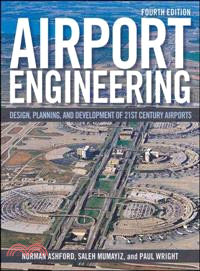Airport Engineering: Planning, Design, And Development Of 21St Century Airports
商品資訊
ISBN13:9780470398555
出版社:John Wiley & Sons Inc
作者:Ashford
出版日:2011/04/06
裝訂/頁數:精裝/768頁
規格:22.9cm*15.2cm*4.4cm (高/寬/厚)
版次:4
商品簡介
作者簡介
Saleh A. Mumayiz is an international consultant in airport planning and development for more than twenty-five years, serving with leading corporations in this field. He served in academic research and continuing education roles in leading U.S. universities. As an active participant in professional (ASCE) and research (TRB) organizations for more than twenty years, he served as chair and member of various TRB and ASCE committees, authoring papers and organizing conferences, workshops, and seminars.
Paul H. Wright is Professor Emeritus at Georgia Institute of Technology. He has been active in continuing education programs and has served as a consultant to transportation agencies in the United States and Central America. The author of numerous papers, he is coauthor of three other books: Highway Engineering, Transportation Engineering: Planning and Design, and Introduction to Engineering.
目次
1 The Structure and Organization of Air Transport.
1.1 The Need for National and International Organizations.
1.2 The International Civil Aviation Organization.
1.3 Nongovernmental Organizations.
1.4 U.S. Governmental Organizations.
1.5 Aviation Planning and Regulation at State Level.
1.6 Patterns of Airport Ownership.
1.7 Revenues and Expenditures at U.S. Airports.
1.8 Sources of Capital Financing for U.S. Airports.
1.9 Federal Financing.
1.10 The U.S. National Plan of Integrated Airport Systems: A Classification of Airports.
2 Forecasting Air Transport Demand.
2.1 Introduction.
2.2 Components of Air Transport Demand.
2.3 Conventional Airport Forecast Methods.
2.4 Integrated Demand Forecast Framework.
2.5 Multiairport Region Forecast Framework.
2.6 Air Trip Distribution Models.
2.7 Modal Choice Models.
2.8 Generation–Distribution Models.
2.9 Air Freight Demand Forecasts.
2.10 General Aviation Forecasts.
2.11 Route Choice Models.
3 Characteristics of Aircraft As They Affect Airports.
3.1 Relationships between Aircraft and Airports.
3.2 The Influence of Aircraft Design on Runway Length.
3.3 Other Airport Layout Factors.
3.4 Factors Affecting Airport Capacity.
3.5 Noise.
3.6 Future Trends in Aircraft Design.
4 Airport System Planning.
4.1 Aviation System Planning.
4.2 Levels of Planning.
4.3 Planning Airport Systems under Different States of Industry.
4.4 Effect of Airline Hubs and Deregulation on U.S. Airport System.
4.5 Air Transport Planning in the United States.
4.6 Airport System Planning in Europe.
4.7 Airport System Plan Analysis.
4.8 Data Structure for Airport System Planning.
5 Airport Master Planning.
5.1 Airport Master Plan: Definition and Objectives.
5.2 Hierarchy of Planning.
5.3 Elements of Airport Master Plan: FAA.
5.4 ICAO Guidelines for Structure of Master Plan.
5.5 Airport Layout Design.
5.6 Data Requirements for Master Planning.
5.7 Structure of Master Plan Report.
5.8 Airport Site Selection.
6 CNS/ATM.
6.1 Evolution of the System.
6.2 U.S. National Airspace System (NAS).
6.3 CNS/ATM of the NAS.
6.4 Next-Generation Systems.
7 Airport Capacity.
7.1 Introduction.
7.2 Capacity, Level of Service, and Demand Peaking.
7.3 Airside Capacity.
7.4 Factors Affecting Airside Capacity and Delay.
7.5 Determination of Runway Capacity and Delay.
7.6 Annual Service Volume.
7.7 Preliminary Capacity Analyses.
7.8 Calculating Aircraft Delay.
7.9 Taxiway Capacity.
7.10 Gate Capacity.
7.11 Assessing System Capacity–Delay for Airport Development.
7.12 Airport Landside Capacity.
8 Airside Configuration and Geometric Design of the Airside.
8.1 Introduction.
8.2 Principles of Airport Layout.
8.3 Airfield Configuration.
8.4 Runway Orientation.
8.5 Obstructions to Airspace: FAA and ICAO Standards.
8.6 Runway Length.
8.7 Clearways and Stopways.
8.8 ICAO Reference Code.
8.9 FAA Airport Reference Code.
8.10 Separation of Parallel Runways.
8.11 Runway and Taxiway Cross Section.
8.12 Object-Clearing Criteria.
8.13 Longitudinal-Grade Design for Runways and Stopways.
8.14 Longitudinal-Grade Design for Taxiways.
8.15 Taxiway Design.
8.16 Holding Aprons.
8.17 Terminal Aprons.
8.18 Summary.
9 Safeguarding the Airport.
9.1 Airport Safety.
9.2 Airport Security.
9.3 Airport Emergency Planning.
9.4 Planning of Airport Security.
9.5 Safeguarding the Airspace.
10 Passenger Terminal.
10.1 Function of Airport Passenger Terminal.
10.2 Terminal User.
10.3 Facilities Required at Passenger Terminal.
10.4 Passenger and Baggage Flow.
10.5 Security Considerations in Passenger Terminal Design and Layout.
10.6 Terminal Design Concepts.
10.7 Vertical Distribution of Activities.
10.8 Passenger Behavior in Terminal.
10.9 Importance of Passenger Terminal Expenditures.
10.10 Space Requirements for Individual Facilities.
10.11 Baggage Handling.
10.12 Terminals for Low-Cost Carriers.
10.13 Expandability, Modularity, and Flexibility.
10.14 Number of Aircraft Gates.
10.15 Parking Configurations and Apron Layout.
10.16 Apron Facilities and Requirements.
11 Air Cargo Facilities.
11.1 Importance of Air Cargo.
11.2 Functions of Cargo Terminal.
11.3 Factors Affecting Size and Form of Cargo Terminal.
11.4 Flow through Airport Cargo Terminal.
11.5 Pallets, Containers, Igloos, and Other Unitized Systems.
11.6 Freight-Carrying Aircraft.
11.7 Documentation and Control.
11.8 Apron Cargo Handling.
11.9 Elements to Be Considered in Design of Air Freight Terminals.
11.10 Example of Design of Middle-Technology Freight Terminal.
11.11 Design of Highly Mechanized Cargo Terminal with Container Stacks and ETV.
11.12 Mail and Express Parcels Facilities.
11.13 Conclusion.
12 Airport Drainage and Pavement Design.
AIRPORT DRAINAGE.
12.1 Introduction.
12.2 Estimation of Runoff.
12.3 Collection and Disposal of Runoff.
12.4 Subsurface Drainage.
STRUCTURAL PAVEMENT DESIGN.
12.5 Introduction.
12.6 Flexible-Pavement Design Methods (U.S. Practice).
12.7 Rigid-Pavement Design Methods (U.S. Practice).
12.8 Pavements for Light Aircraft.
12.9 Aircraft and Pavement Classification Numbers.
13 Airport Access.
13.1 Access Problem.
13.2 Determining Mix of Access Modes.
13.3 Available Access Modes.
13.4 Access Modal Choice Models.
13.5 Parking Space at Airports.
13.6 Curbfront Design.
13.7 Capacity of Access Routes.
13.8 Layout of Access.
13.9 Summary.
14 Heliports, STOLports, and Vertiports.
14.1 Introduction.
14.2 Helicopter Characteristics and Trends.
14.3 Planning and Design of Heliports.
14.4 Planning and Design of STOLports.
14.5 Planning and Design of STOL Facilities
14.6 Planning and Design of Vertiports.
15 Airport Modeling and Simulation.
15.1 Introduction.
15.2 Definitions and Concepts.
15.3 Airport Simulations.
15.4 Airfield–Airspace Simulation.
15.5 Environmental Simulation Models.
15.6 Airport–Landside Simulation.
15.7 Airport GIS.
16 Airport City.
16.1 Introduction.
16.2 Global City.
16.3 Building Blocks of Airport City.
16.4 Anatomy of Aerotropolis.
16.5 Airport Cities of the World.
16.6 Planning of Airport City and Aerotropolis.
17 Environmental Impacts of Airports.
17.1 Introduction.
17.2 Environmental Legislation.
17.3 Airport Environmental Guidance.
17.4 Environmental Review Process.
17.5 Air Emissions/Quality.
17.6 Biodiversity and Natural Resources.
17.7 Historic, Archaeological, Architectural, and Cultural Resources.
17.8 Noise and Land Use.
17.9 Social and Socioeconomic Resources.
17.10 Waste Management.
17.11 Water Resources.
17.12 Sustainable Development.
Index.
主題書展
更多書展今日66折
您曾經瀏覽過的商品
購物須知
外文書商品之書封,為出版社提供之樣本。實際出貨商品,以出版社所提供之現有版本為主。部份書籍,因出版社供應狀況特殊,匯率將依實際狀況做調整。
無庫存之商品,在您完成訂單程序之後,將以空運的方式為你下單調貨。為了縮短等待的時間,建議您將外文書與其他商品分開下單,以獲得最快的取貨速度,平均調貨時間為1~2個月。
為了保護您的權益,「三民網路書店」提供會員七日商品鑑賞期(收到商品為起始日)。
若要辦理退貨,請在商品鑑賞期內寄回,且商品必須是全新狀態與完整包裝(商品、附件、發票、隨貨贈品等)否則恕不接受退貨。
























